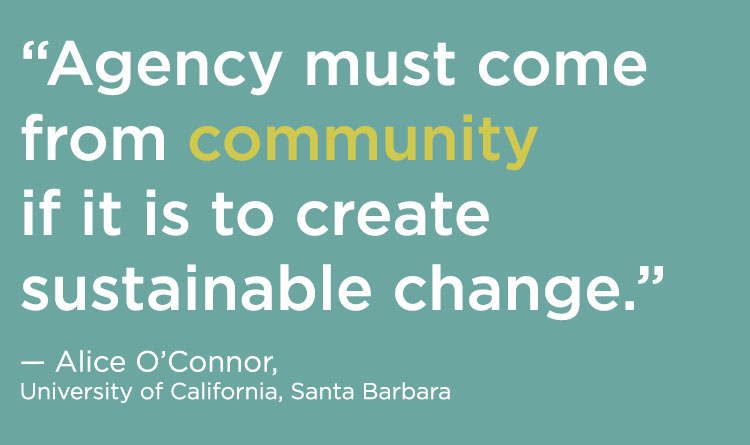Isis Ferguson, Place Lab program manager, attended the Making the West Side Public Forum and Reception on May 19 at the Jane Addams Hull-House Museum. In this SITE entry, Isis shares some reflections and takeaways from her experience at the event.
Alice O’Connor participated in the wrap-up portion of the program. It’s been more than a week since she made her remarks, and I am still moved by the notion of inevitability briefly mentioned by O’Connor.
Neighborhood development efforts often focus on thwarting rapid change, a kind of fundamental alteration that ushers in new amenities, tourists or “pioneering” new residents, resulting in the dislocation or displacement of neighborhood residents and entrepreneurs. In short, locals get priced out. Ironically, in this neighborhood development scenario, it is often the very same local people who made a place work—made it vibrant, attractive, and distinctive—that end up “choosing” to leave. The staying power of locals for as long as some are able to hold out, is extraordinary considering it is done against the crushing weight of redlining, restrictive covenants, de jure segregation and other policies or practices deployed to maintain systems of inequality.
The evolution of a neighborhood does not have to follow a singular, certain path of transformation.
I’m interested in exploring with others the processes and strategies that have historically been enacted to preserve neighborhood identity, authenticity and resident agency while simultaneously embracing the fluidity and continuous development that is at the heart of vibrant communities.
Isn’t displacement avoidable? Can’t we find examples or create circumstances and policies so that development and redevelopment do not have to be synonymous with gentrification?
On May 27, The New York Times published The End of Black Harlem, an article by Michael Henry Adams lamenting the rapid gentrification of a section of NYC once considered the epicenter of black cultural life in America. Adams mentions a conversation he has with a group of neighborhood boys curious about a demonstration chant they hear, "Save Harlem Now!" Adam reflects, "It was painful to realize how even a kid could see in every new building, every historic renovation, every boutique clothing shop—indeed in every tree and every flower in every park improvement—not a life-enhancing benefit, but a harbinger of his own displacement.”
““These are people who, in saying ‘I don’t see color,’ treat the neighborhood like a blank slate. They have no idea how insulting they are being, denying us our heritage and our stake in Harlem’s future. And, far from government intervention to keep us in our homes, houses of worship and schools, to protect buildings emblematic of black history, we see policies like destructive zoning, with false “trickle down” affordability, changes that incentivize yet more gentrification, sure to transfigure our Harlem forever.””
Adam’s narrative about Harlem in the contemporary moment connects to a long legacy of urban policies which have had deeply felt material, social and financial consequences on people and place. Harlem’s own son, writer James Baldwin, famously stated in 1963 that federal 'Urban Renewal' policies were actually a not-so-thinly veiled practice of 'Negro Removal.' This observation has relevance and potency in the changing urban landscapes of Harlem in New York, Detroit, and Chicago in 2016.
For those of us committed to the dynamism of communities, what case studies can we be pointed to that provide tactics and approaches for resiliency that also include a space for change and variation? To push and mobilize for more equitable cities, people need more options than blight/stagnation on one end and investment/
gentrification on the other end of the spectrum. I look forward to the numerous Making the West Side community conversation programs that JAHHM has planned throughout the year.
— Isis Ferguson, May 2016
RSVP for the Public Convening on Ethical Redevelopment, a free and open public event at which Place Lab will explore and showcase how residents, artists, entrepreneurs, developers, and civic leaders are joining forces in a more equitable process for community revitalization.


